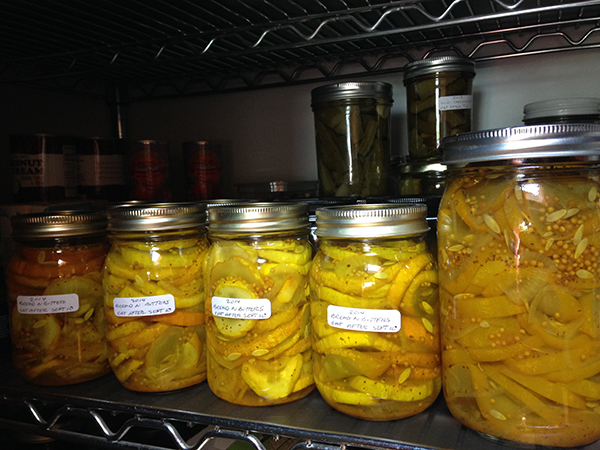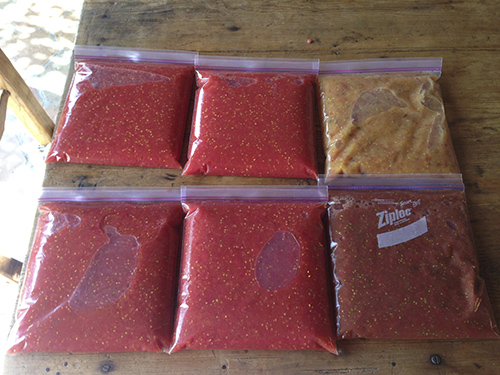
From left- bread and butter, cornichons, and dill pickles
Following are the recipes I use for each of them:
BREAD AND BUTTER PICKLES II (I modified this from Allrecipes.com)
Makes 8 one quart jars or 16 pints-you can make smaller amounts if you want
25 cucumbers, scrubbed, cleaned, and sliced, blossom end cut off (the pickles will get discolored if left on)
6 onions, thinly sliced
3 cloves garlic. sliced
1/2 cup salt
3 cups white vinegar
5 cups white sugar
2 tablespoons mustard seeds
1 1/2 tablespoons celery seed
1/2 teaspoon whole cloves
1 tablespoon tumeric
DIRECTIONS:
1. In a large bowl, mix together cucumbers, onions, garlic and salt. Allow to sit 3 hours.
2. In a large saucepan mix together the vinegar, sugar, mustard seed, celery seed, whole cloves, and turmeric. Bring to a boil.
3. Drain liquid from cucumber mixture. Rinse and drain cucumbers. Stir the cucumbers mixture into the boiling vinegar mixture. Remove from heat just before it returns to a boil.
4. Transfer to sterile containers. Seal and chill in the refrigerator for one month before eating or process in water bath for 10 minutes or 15 minutes for our high altitude. (Add an additional 15 minutes for our 7000′ high altitude) I put some in the refrigerator and process the others. For water bath process, store in a cool dry place and wait one month before eating. Refrigerate after opening.
Be sure to wait one month before eating, whether making refrigerator style or water bath process-the flavors permeate the cucumbers better. Once I couldn’t wait and opened a jar after 2 weeks but it was not as flavorful. It’s worth the wait.
REALLY QUICK DILL PICKLES (from ‘The Joy of Pickling’)
Makes 3 one quart jars or 6 pints-this is a no brine method
-For firmer pickles, add 2-3 grape leaves or 6-8 sour cherry leaves of each qt of pickles but it is not necessary.
You can double or triple this recipe to fit your harvest.
ONE QUART METHOD
DIRECTIONS:
To make a single qt of pickles, you’ll need 1 cup water, 7/8 cup vinegar=3/4 cup + 2 tablespoons vinegar, 8 peppercorns, 2 garlic cloves, pinch of dried pepper flakes, 1 dill head. Pour boiling liquid mixture over packed cleaned cucumbers in jars. Leave 1/2 inch headroom in jar. Seal and process. See below.
3 QUART OR 6 PINTS METHOD
DIRECTIONS:
4 lbs of cucumbers, scrubbed and cleaned, blossom end cut off (the pickles will get discolored if left on)
24 peppercorns
1 garlic head, peeled and sliced
dried pepper flakes to taste
fresh dill heads (or dill seeds if fresh dill not available)
2 3/4 cup white vinegar
3 cups water
1/4 cup pickling salt (or non iodized salt)
1. Half or quarter cucumbers lengthwise. Divide the peppercorns,garlic, and hot peppers (if you are using them) among 6 pint or 3 quart mason jars. Pack the cucumbers in tightly into the jars.
2. In a saucepan, bring the vinegar, water, and salt to a boil, stirring to dissolve the salt. Pour the hot liquid over the cucumbers, leaving 1/2 inch headspace. Close the jars with the 2 piece caps. In a boiling water bath, process the jars for 10 minutes, quart jars 15 minutes (Add an additional 15 minutes more for our 7000 ft high altitude).
3. Store in a cool dry place and wait one month before eating. Refrigerate after opening.
FRESH PACKED REFRIGERATOR DILL PICKLES –LEMON DILLS (from ‘The Big Book of Preserving The Harvest’)
Makes 1 quart or 2 pints
10-14 pickling cucumbers, scrubbed and cleaned, blossom end cut off (the pickles will get discolored if left on)
3 sprigs dill
2 cloves
1/2 cup fresh lemon juice
cold water
DIRECTIONS:
1. Pack sterilized jars with cucumbers, dill, and garlic leaving 1/2 inch headspace
2. pour the lemon juice over the cucumbers
3. Seal and refrigerate. These will keep 6 weeks or more in refrigerator. Wait one -2 weeks for flavors to blend.
SHORT BRINED DILL PICKLES (from ‘The Joy of Pickling’)
Makes about 8 quarts
-This recipe is very flexible as long as you keep the proportions of vinegar, water salt and sugar. You can vary the seasonings as you like.
-For firmer pickles, add 2-3 grape leaves or 6-8 sour cherry leaves of each qt of pickles but it is not necessary.
ONE QUART METHOD
DIRECTIONS:
You may prefer to make your pickles by the quart. For this, drop into each jar 2 sliced garlic cloves, 4 peppercorns, and pinch of hot pepper flakes. Pack the cucumbers into the jars with 2-3 heads of dill and pour over the cucumbers a hot solution of 1 cup each vinegar and water with 1 1/2 teaspoons sugar and 2 teaspoons salt. Leave 1/2 inch headroom at top of jar. In a boiling water bath, process the jars for 10 minutes, quart jars 15 minutes (Add an additional 15 minutes more for our 7000 ft high altitude) Store in a cool dry place and wait one month before eating. Refrigerate after opening.
8 QUART METHOD
12 lbs 3-5 inch cucumbers, scrubbed and cleaned, blossom end removed
1 1/2 cups pickling salt
2 gallons plus 2 quarts water
7 1/3 cups white vinegar
1/4 cup sugar
16 cloves garlic, sliced
32 peppercorns
16-24 heads of dill
dried hot pepper flakes (if desired)
DIRECTIONS:
1. Half or quarter cucumbers lengthwise or leave whole. In a very large bowl or soup pot or crock, dissolve 3/4 cup pickling salt in 2 gallons of water. Add the cucumbers and weight them with a heavy plate that just fit the container. Let stand in the brine at room temperature for 8-12 hours.
2. Drain the cucumbers. If you like less salty pickles, rinse well and drain them again.
3. In a non reactive pot, bring to a boil the remaining 3/4 cup pickling salt, the remaining 2 quarts water, the vinegar, and the sugar. While the mixture heats, divide the garlic and peppercorns amount the 8 quarts or 16 pint mason jars. Pack the cucumbers, dill, hot pepper (and grape or sour cherry leaves if you are using them).
4. Pour the hot liquid over the cucumbers, leaving 1/2 headspace. Close and in a boiling process pint jars for 10 minutes, quart jars for 15 minutes (Add an additional 15 minutes for out altitude at 7000 ft high) Store in a cool dry place and wait one month before eating. Refrigerate after opening.
CORNICHONS (from ‘The Foodlovers Guide to Paris’) tiny tart pickles
Makes 2 quarts or 4 pints- you can make smaller portion by cutting the recipe in half.
60 two inch small pickling cucumbers
1/4 cup kosher or pickling salt
1 quart water plus
3 cups white vinegar
1 tablespoon sugar
12 small white pickling onions
4 large sprigs fresh tarragon
6 cloves garlic sliced
dried hot peppercorns
2 bay leaves
DIRECTIONS:
1. Trim off stem ends of cucumbers, rinse and drain.
2. In a large bowl combine the salt with one quart water. Stir until the salt is dissolved, add the cucumbers and let stand for 6 hours.
3. Drain the cucumbers, discarding the salted water. I like to rinse them.
4. In a medium saucepan over medium heat combine the vinegar, 1 1/2 cups water and the sugar and bring to a boil. Layer the jars with the drained cucumbers, onions, herbs and spices. Pour the boiling vinegar mixture into the jars leaving 1/2 headspace. In a boiling water bath, process the jars for 10 minutes, quart jars 15 minutes (Add an additional 15 minutes more for our 7000 ft high altitude) Store in a cool dry place and wait one month before eating. Refrigerate after opening. You can also just refrigerate them but still wait one month before eating.













